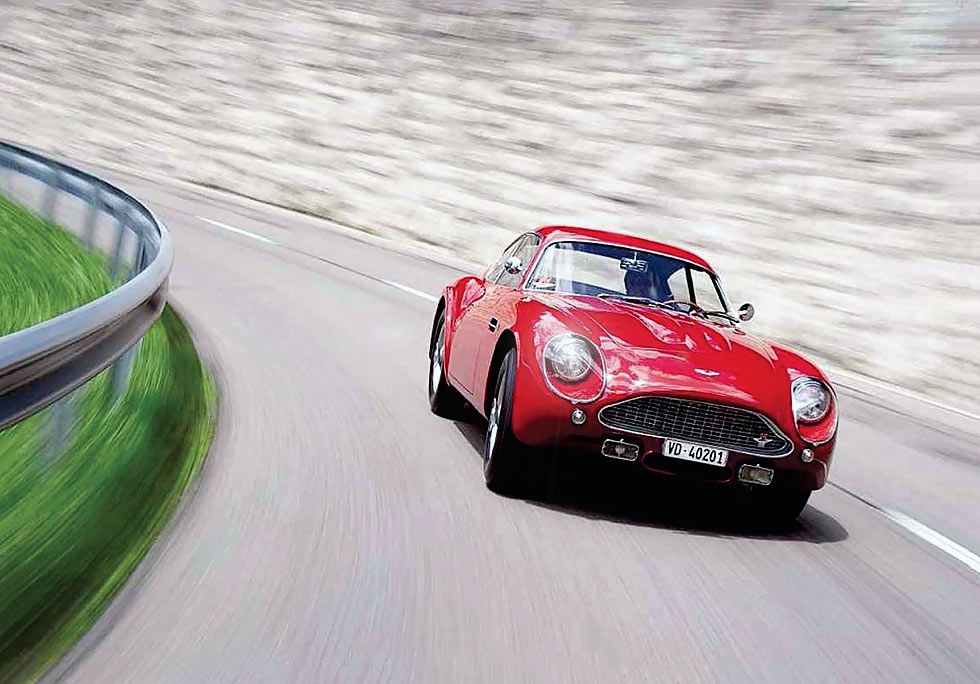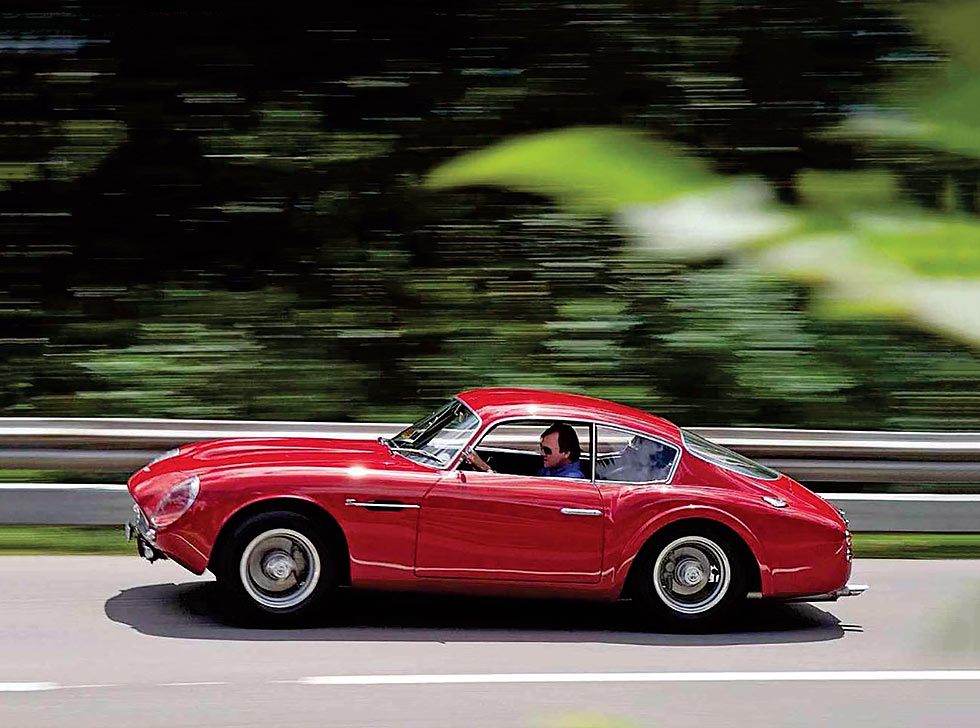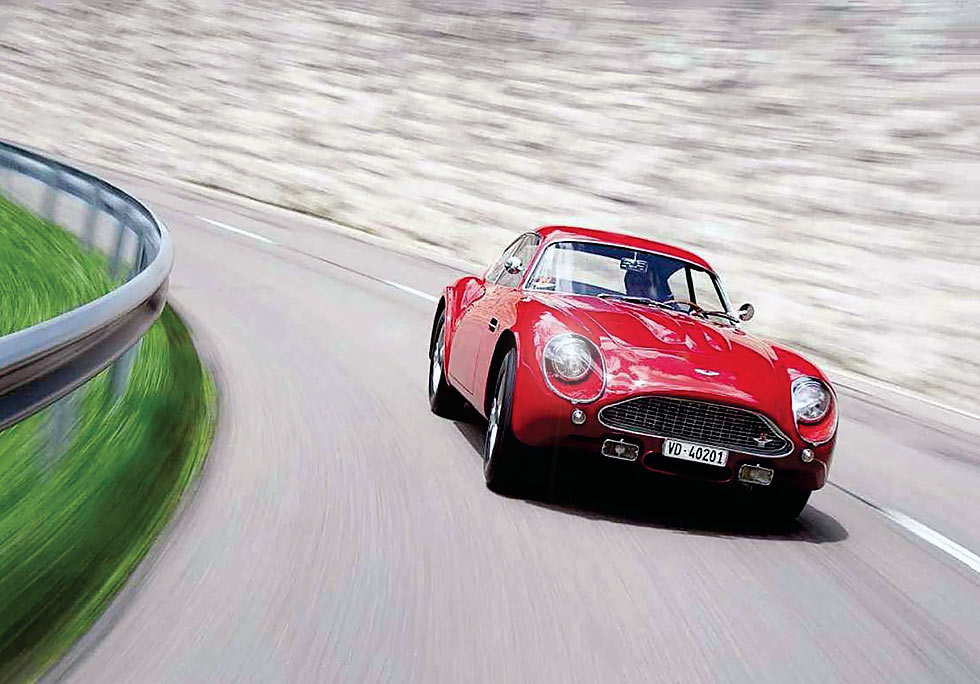
The mark of Zagato… Aston Martin DB4GT Zagato 50th anniversary celebration drive. It’s one of the most beautiful cars of all time and now it’s hit 50. Time to drive the Geneva Show car on home ground Words Robert Coucher Photography Paul Harmer.
A classic Cars desirability is generally determined by three factors: beauty, rarity and sporting provenance. That’s why the Ferrari 250GTO is one of the most coveted: it rates highly on all three counts. The Ferrari 250GT SWB is more numerous than the GTO but it scores high on beauty and competitive achievement. The 1961 Aston Martin DB4GT Zagato is also one of the most desirable classic cars. It is beautiful and rare but. In reality, it never did as well as expected on the racetrack.

The DB4GT Zagato competed with some success but never quite made the first team. Its lack of success was down to bad timing. It was too heavy and too old-fashioned to take on first the SWB and then the GTO. Yet invest some time in looking at one and driving it on flowing mountain roads and you cannot fail to be beguiled. It’s one of the most delectable-looking classics of all time and now it’s 50 years old.

This one – DB4GT/0178/L- is finished in its original Ferrari-esque red, which is a bit of an irony, and it is in highly original condition. When it was completed on 8 March 1961 it was recorded as being painted in Zagato two-tone, Range Rosso on the upper body and Maja on the bottom. Fortunately it seems the car was not actually delivered in this challenging combination of hues but arrived in plain red. According to the records it was the fourth Zagato built and it was sold as chassis only’ to Zagato, having been road tested and approved for warranty by Des O’Dell at the Aston Martin service department.
After being shipped to the Swiss agent Hubert Patthey, this car was sold to Monsieur Edy Corthesy of Lausanne but, before delivering it, Patthey had the Zagato carefully preparedand presented it at the 1961 Geneva Motor Show on behalf of Aston Martin.
‘You open the flyweight ally door with its Perspex window and savour the aroma of the gently worn Connolly leather interior’
Monsieur Corthesy was obviously well-heeled, buying the sporting Zagato for £5470 when the hottest 3.8-litre Jaguar XK150S was priced at a mere £2000. And just two months after Geneva, the car made its competition debut, competing at the Grand Prix of Spa Francorchamps; Corthesy finished, although his classification is not known. Seems he gave the Zag a bit of a go because, three days later, the car was back at the factory undergoing some remedial bodywork, and the engine’s compression ratio was raised.
Records show that the Zagato was then sold to student Fridolin Haechler, who later became chief of police in Bern. As well as being Swiss, he had an address in New York so the car was shipped over there with the intention of racing in SCCA events. But that never materialised and the Zagato was sold to Newton Davis in 1962 for $4000, then to Chris Murray of Massachusetts, who rebuilt the engine, transmission and brakes and had the car resprayed in red acrylic to match the original colour. Dr Keith Lewin took ownership after that and had the Aston retrimmed in black leather. It was purchased by Jerry Rosenstock of California in 1972 with just 28,000km on the clock. He showed it at various concours events and competed with it at club track events in America.
So this car’s history is varied and extremely well documented. Now back in Switzerland once again, Aston Martin DBZ 0178 looks in fine condition and its continuous recorded history and low mileage make it a very desirable example of the mere 19 ever constructed by the Zagato carrozzeria.
Parked on the side of a mountain road that snakes through the Alps, the Aston looks superb. Whereas the Superleggera coachwork of the DB4 and DB4 GT by Carrozzeria Touring looks restrained and understated, the voluptuous and flowing lines of the Zagato are much more expressive and exciting, with the coachbuilder’s signature double-bubble appearing not on the roof but on the bonnet.

Having bought Aston Martin in 1947. David Brown sent his stylist Frank Feeley to Italy to learn from the great carozzerie and, on his return to Aston at Newport Pagnell, Feeley penned the DB2, which went into production in 1950. When Feeley left Aston, Brown and his general manager John Wyer went back to Touring for the styling of the replacement DB4, presented at the 1958 London Motor Show. This was followed in 1959 by the DB4GT, which was shorter than the DB4 by five inches in wheelbase and overall length and also some 85kg lighter.
The DOHC 3.7-litre straight-six engine’s power was increased from 240 to 302bhp thanks to head work and three Webers replacing the DB4’s twin SUs. The third model, as you see here, is the DB4GT Zagato, carrying still less weight and with power increased to a claimed 314bhp.
Founded in 1919, Zagato was well respected for its lightweight yet strong coachwork that proved itself on Alfa Romeos, Fiats, Lancias and Ferraris when racing as wett as on tough road events such as the Milte Miglia. In 1956 a 23-year-old called Ercole Spada joined the company and it was he who designed the beautiful DB4 Zagato. The process began with a chassis being sent from the factory and Spada did a rough sketch of what he thought the car should look like, followed by a number of three-quarter-angle drawings and ending up with a 1:5 wooden scale model and a full-sized technical drawing. With Aston’s approval the first DB4GT Zagato was constructed for the Earls Court Motor Show in 1960.
As you will notice from the Aston Martin DB4’s evolution to GT and then to GT Zagato, there was a constant attempt to reduce the cars’ weight as well as increasing their power output, respectively from 1311kg and 240bhp to 1209kg and a claimed 314bhp with the Zagato. Racing had been on the cards since the Zagato’s inception and two cars were built for John Ogier’s famous Essex Racing Stable, registered 1VEV and 2VEV, and they debuted at the 1961 Le Mans 24 Hours race, driven by Jack Fairman and Bernhard Costen, and Australians Lex Davidson and Bib Stillwell.
A third car was entered by French distributor Marcel Blondeau for Jean Kerguen and Claud Dewez. The Ogier cars retired within the first three hours due to blown cylinder head gaskets and the French car made it to the 24th hour in ninth place but retired with dramatic timing when it failed to restart during a late pit stop.
Both VEV cars and a GT were then entered in the Tourist Trophy at Goodwood with Roy Salvadori, Jim Clark and Innes Ireland as drivers. But Ferrari brought along two SWBs, driven by Stirling Moss and Mike Parkes, who proceeded to pull away from the Zagatos with ease in the three-hour race. It’s interesting to note that, while Salvadori and Clark used 14 tyres for the race, Moss only used ten in the SWB as it was more powerful than the Aston and a considerable 12% lighter.
Another three-hour GT race at Monza saw Tony Maggs finishing second in 1VEV behind a Ferrari while, at the 1000km race at Montlhery, 1VEV (driven by Clark and Ireland) and 2VEV (Maggs and Whitmore) finished fifth and ninth respectively. In 1962 Ferrari unveiled its superb GTO and the Zagato’s racing career was toast.
But though it was not an absolute race-winner, the Zagato was driven by some of the greatest drivers of the era at the most evocative race meetings and made a damn good fist of racing even though it w a s bested by Ferrari, whose cars were lighter, stiffer and faster. Vet those who were there recall these great drivers four-wheel drifting the game old Astons in hot pursuit of Maranello’s finest. The impression remains of the outclassed British underdog doing its best.
In today’s world, if you really want to win races, drive a Cobra or Lightweight E-type and save the rare DB4GT Zagato. Aston racers have found that the DB4GT offers almost identical performance with a relatively less astounding price tag, and the Tadek Marek-designed 3.7-litre six-cylinder engine, which only really produced 270bhp in period, can now be improved (if not actually stretched in capacity!) to nearly 320bhp, making the GT a competitive and enjoyable track racer.
Of the 19 Zagatos built, 11 were right-hand drive – the left-handed 0178 we have here is far too good to be raced. Being careful not to lean on any of the extremely light aluminium body panels, you open the flyweight ally door with its Perspex window and savour the aroma of the gently worn Connolly leather interior. The open-back chairs with their seat buttons look small but prove comfortable, if short in the back and not as luxurious as the full DBA jobs. Smiths’ instruments are visible through the beautifully made three-spoke wood-rimmed steering wheel, and look fabulous in the binnacle of the soft-black painted dashboard (sans glovebox lid). The gearlever, accessing four forward ratios, appears delicate, while the floor pedals are man-sized.
The light door shuts with a less than Mercedes-like clack and you notice the ally-edged Perspex window does not butt tight up against its seal. Turn the ignition key, give the three Weber carbs a few priming pumps, and the six spins on the starter, then fires with a big sound. A bit more throttle clears the choke tubes and the engine settles down to idle. It sounds as big and as heavy as it looks under the bonnet but it is refined and not excessively noisy.
The clutch pedal is not particularly heavy but it has a long movement. Select first and you find that the Aston needs some revs when moving off as it’s a high gear. The Webers snuffle and pop a bit but, once sucking air, they smooth out and deliver the power. The gearshift is slick, the ratios tightly stacked. Squeeze the throttle pedal and the Aston attacks the tight mountain bends with enthusiasm, its rack-and-pinion steering sharp, making the car feel significantly livelier and more responsive than the DB4 we tested in Drive-My.
This highly original car runs on original spec 6x16in Avon Turbospeed tyres, which help keep the steering light and accurate. As you give the Aston its head through some of the faster sections you notice how soft and pliant the ride is. Unfortunately the rear suspension employs imprecise Armstrong lever-arm dampers that, combined with ample weight and a less-than-rigid chassis, allow the Zagato to wallow more than you might like a s speed increases.
Which is where the Aston’s rival has the advantage. A Ferrari SWB is considerably lighter and much more rigid. It also has a simple solid rear axle but it is better controlled with Koni telescopic dampers, semi-elliptic springs and two torque arms on each side. The Ferrari is saddled with a traditional steering box but, as was illustrated in a recent drive in a SWB, it feels more accurate and precise than the Aston’s and is therefore faster though the bends. But on these steep and undulating mountain roads, the Zagato’s engine, especially its fat gob of torque that comes into play smack in the middle of the rev range, more than makes up for its vintage handling. The car wants to understeer and that makes it easy to dive into downhill corners, although the non-servoe’d Girling disc brakes, with a long-travel pedal, instil a degree of circumspection.
Make no mistake: the Zagato is bloody fast. It will dash to 60mph in 6.1sec and storm on to 150mph with this gearing. Learning its foibles, you soon start to drive it within its comfort zone and, at that rate, it is a big, friendly labrador of a car.
Sitting in the spare interior, the eager engine responding to the input of your right foot, the Aston is a wonderful experience, its exhaust note through the twin tailpipes as classy as you can get, the big engine willing you to cream it to the red line and reacting with sonorous enthusiasm. Get used to the long-travel brake pedal and you apply the anchors early, chuck the car in before the apex, allow the skinny tyres to start a bit of lateral movement, then slide the Aston through on the responsive throttle.
The soft suspension allows the car to lean and the front end will eventually wash wide of the apex but, if you mess up the cornering speed, simply mash the throttle again and the powerful lump will pull it back together as speed rises down the next straight.
Away from the mountains and onto faster B-roads the Aston really comes into its own. With the view along the evocative double-bubble bonnet enhanced by the sight of a fat rear haunch in the rear-view mirror, the Zag bowls along, guided gently via that superb thin-rimmed steering wheel. You loosen your grip and allow the car to move about a bit on its old-tech tyres while enjoying its powerful but well-mannered responses. With hindsight you can criticise the Aston Martin DB4GT Zagato for being a road car that was turned into a racing car, whereas the Ferrari SWB was a racing car adapted for road use. But that’s missing the point.
On a fast road the Aston remains an absolute pleasure. It looks simply ravishing, it sounds glorious, and it responds to your inputs with faithful obedience. It might fall short of being the best circuit racer, but so what? It is a proper thoroughbred that makes its driver feel like a million dollars. Actually, more like five million dollars.
Thanks to Geneva-based broker Kidston SA, www.kidston.com, for arranging the drive.
TECHNICAL DATA FILE SPECIFICATIONS 1961 Aston Martin DB4 GT Zagato
ENGINE 3749cc all alloy straight-six, DOHC, three Weber 45DCOE4 carburettors
MAX POWER 314bhp @ 6000rpm / DIN
MAX TORQUE 278lb ft @ 5400rpm / DIN
STEERING Rack and pinion
SUSPENSION Front, double wishbones, coil springs, telescopic dampers, anti-roll bar. Rear: live axle, trailing arms, coil springs, Watts linkage, lever arm dampers.
BRAKES Discs front and rear, no servo
WEIGHT 1209kg
PERFORMANCE Top speed 152mph. 0-60mph 6.1sec
‘Whereas the Superleggera coachwork of Touring’s DB4 and DB4GT looks understated, the voluptuous and flowing lines of the Zagato are much more exciting’
Above and right Despite its short wheelbase, the Zagato is superbly proportioned. It wears exquisite detailing. Above Robert Coucher lives the dream: one of the world’s most beautiful cars on the roads that snake out of Geneva. Top and above Interior is simple and understated; 3,7-litre twin-cam straight six is tuned for a useful 314bhp.
Right Not much in the way of luxury in here, but that’s not the point of this Aston. Instead it’s hugely purposeful. Above Look at this picture long enough and you’ll almost hear the evocative burble of those twin tailpipes.






